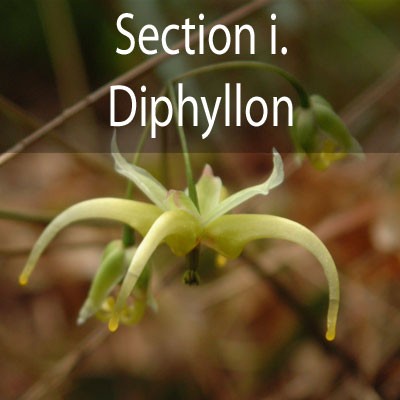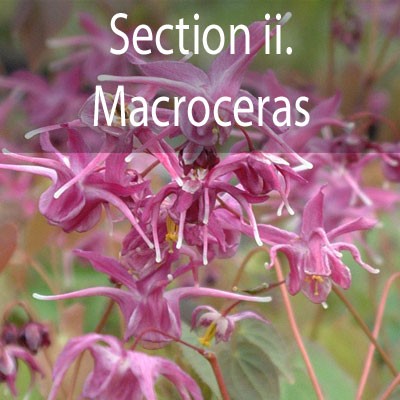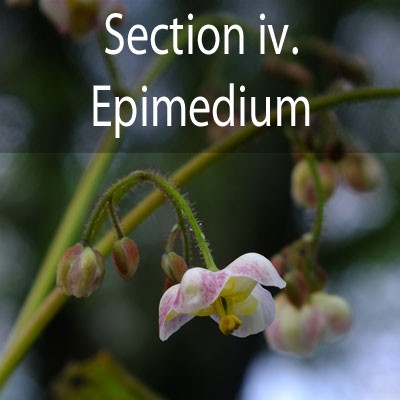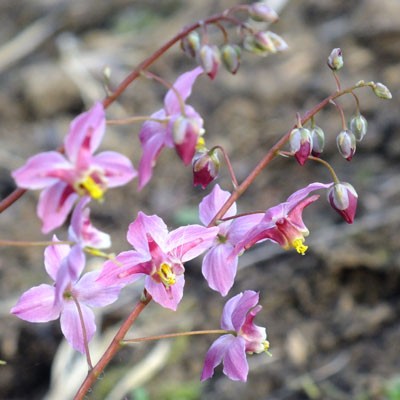-
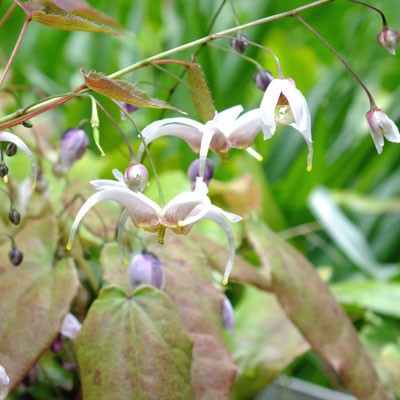
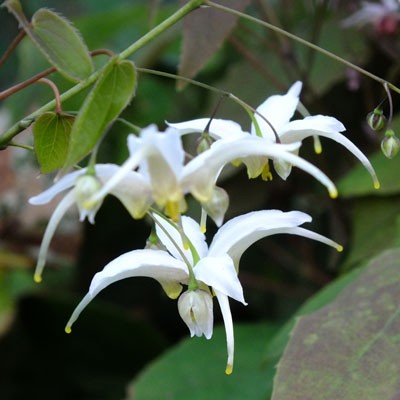
Potsize - 1L
The flowers consist of a wide open claw of 4 petal horns that are a creamy white, becoming yellow stained towards the mouth. The sepals, which are a similar white, start curved along the petal, later flaring backwards to add more shape to the flower. The leaf edge tends towards smooth with a gently rounded curve to the narrow tip. In Winter the green remains, but is overlain with burgundy tones, especially in the veins. They open with a coppery flush. A species that shows great variability in the wild. Series C - DolichoceraeLinks
Epimedium Compared
Botanical Style Photographs
-
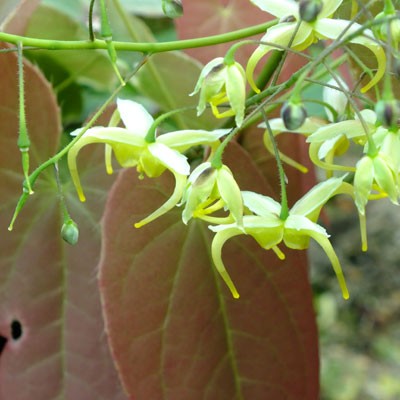
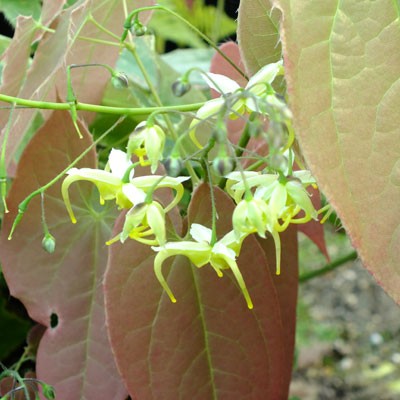
Potsize - 1L
Collected by the great Japanese Epimedium expert Mikinori Ogisu you know that this is going to be something good. And so it is. The new leaves are just the most lovely shades of crimson, providing the perfect foil for the bright lemon yellow flowers. It doesn't sound special when written down, but there is just something about the way that the leaves glow that is so right. The way the petals curve inwards can give the flowers the appearance of so many spiders dangling from the arching stems, but that is to deny their undoubted beauty. The flowers are a strong lemony yellow which look absolutely great against the broad foliage. Winter leaves can colour pale ochre with dark pink veins. From Hubei and Guizhou provinces, China. Named by Professor Stearn. Series C - DolichoceraeLinks
Epimedium Compared
Botanical Style Photographs
-
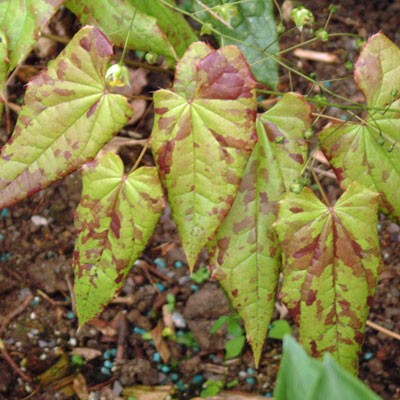
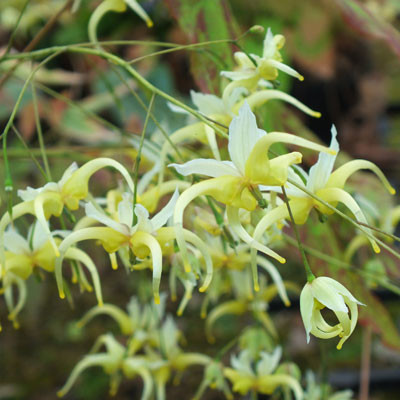
Epimedium chlorandrum
£9.00Potsize - 1L
The flowers of this species are typical of the series, being a wide spidery cross in an almost translucent pale lemon yellow. The leaves however are something to behold, being large with three arrow shaped leaflets, apple green with a gorgeous variable overlay of maroon blotching. Two botanical details separate this species from the others in its series. The first is that the sepals are not closely pressed to the petals, but instead arch back to give the flower a little more character. The second, which you can be excused for missing, is that the pollen is green rather than yellow. This feature does however give the species its name. Subgenus Epimedium, Section i, C Series - DolichoceraeLinks
Epimedium Compared
Botanical Style Photographs
-
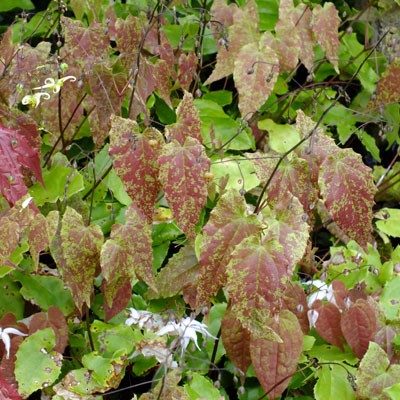

Epimedium ‘Amber Queen’
£9.00Potsize - 1L
This is a really showy variety that produces an absolute swarm of flowers in a lovely soft apricot colour. It is vigorous with tall upright flowering stems that produce large, well spaced flowers with petals that shade from lemon yellow at the tip, through orange to a deep but narrow red mouth. Each flower has petals that sweep back like each flower is skydiving. New leaves are heavily splashed with red as a further bonus. E.flavum x E.wushanenseLinks
Epimedium Compared
Botanical Style Photographs
-
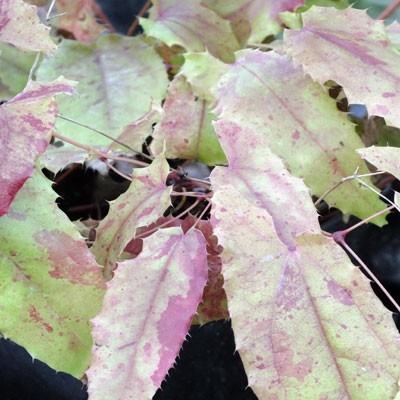
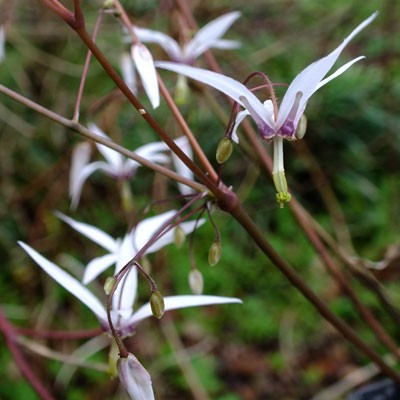
Epimedium fargesii
£10.00Potsize - 1L
An elegant plant with strong flowering stems bearing a pair of tri-foliate beautiful bronzy leaflets set amongst an elegant spray of pendulous white and violet deeply reflexed flowers reminiscent of a stellar pelargonium or miniature shuttlecock. Individual flowers are 3 - 3.5cm wide with the outer sepals faintly tinged violet creating a delicate starry effect. The inner petals are purple violet and arch back into the sepals whilst the stamens protrude, creating an ochre coloured 'beak'. The flower stems can be between 20-50cm high. The leaves are in 3 leaflets, long, arrow-shaped and a beautiful pinky bronze when young, remaining irregularly red blotched when older. They are softly pink and serrated, thick textured and persist well into winter. The fact that the leaf edges undulate with alternate paler green spines pointing either up or down creates real texture and interest. Originally collected by the French missionary Paul Guillaume Farges in Sichuan province, China. Until dolichostemmon was discovered, this Epimedium was unique for its fully reflexed flowers. Subgenus Epimedium, Section i, D Series - Brachycerae
Links
Epimedium Compared
Botanical Style Photographs
-
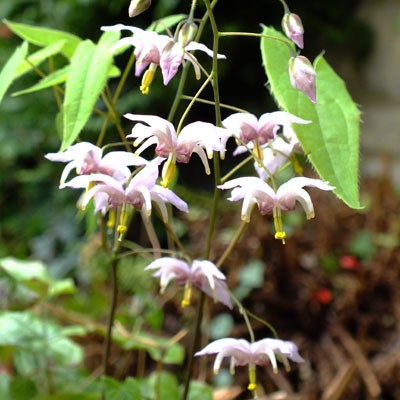
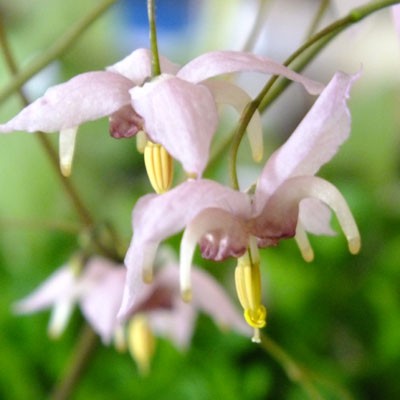
Epimedium ‘Enchantress’
£9.00Potsize - 1L
Possibly E.dolichostemon x E.leptorrhizum. A lovely introduction from Elizabeth Strangman with flowers in a gentle soft pink, very much like its parent E.leptorrhizum. However, each flower is neater and smaller and held in an elegant arching spray. The leaves can colour a rich ruby red in winter.Links
Epimedium Compared
Botanical Style Photographs
-
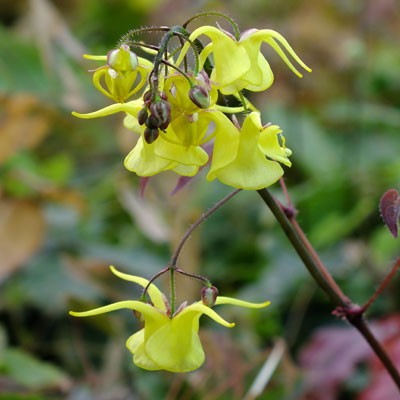

Potsize - 1L
Startling fat goblet shaped flowers of brightest yellow with yellow horns. The sepals are reduced to a little fleck of rusty red which is picked up by the dark red of the new leaves. The flowers are 1 1/4 inches but the 'tube' is flared to make the goblet shaped centre which lends the flower more weight. Originally collected by the French missionary, Pere Armand David. From mountain woods in the Sichuan province. Subgenus Epimedium, Section i, B Series - DavidianaeLinks
Epimedium Compared
Botanical Style Photographs
-
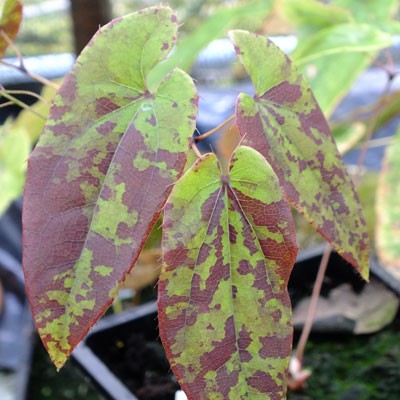
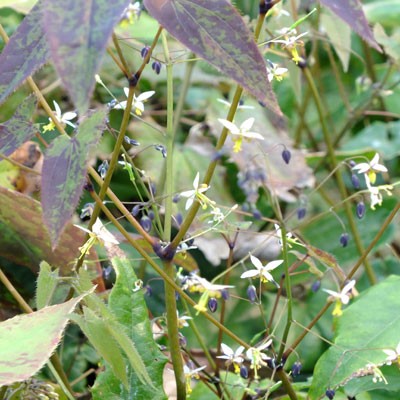
Epimedium myrianthum
£9.00Potsize - 1L
The flowers of this variety are tiny, but more than made up for by the immense profusion in which they are produced creating a cloud of tiny butterflies. Each flower is starry and white, made up mostly of the sepal, with tiny brown incurved petals. The stamens are prominent and yellow so that the overall shape of each flower echoes a dodecatheon. The flowering stems are black, as are the buds which makes a good contrast. Unlike the flowers, the leaves are relatively large, and emerge in a fabulous bright green, heavily overlaid with deep burgundy-red. Subgenus Epimedium, Section i, D Series - BrachyceraeLinks
Epimedium Compared
Botanical Style Photographs
-
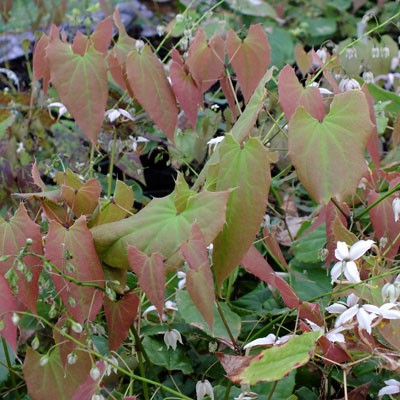

Epimedium ‘Jean O’Neill’
£9.00Potsize - 1L
Jean O'Neill has flowers in one of those colours that is quite unique. The flowers are generous in proportions and production, with each being topped by off white sepals, under which curve petals which shade from dunked rich tea biscuit brown to flesh coloured at their curved tips. Young leaves are suffused with a rich tan and they colour a lovely pinky-red in Autumn, still with the darker red speckles. Raised at Spinners by Peter Chapell from Epimedium davidii seed. Possibly a cross with Epimedium acuminatumLinks
Epimedium Compared
Botanical Style Photographs
-
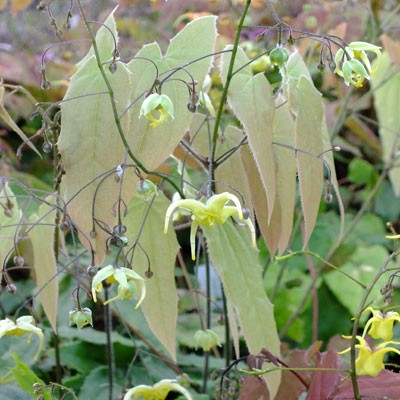
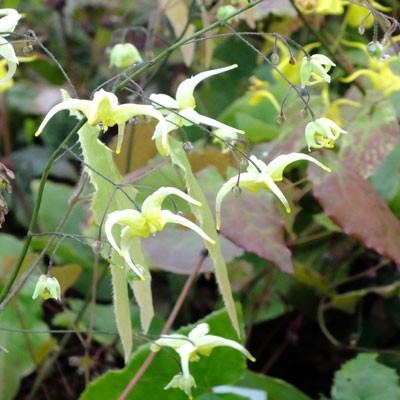
Potsize - 1L
The flowers remind us of an upside down quoit board with the petals curving down at 90 degrees to the plane of the flower in a pale lemony yellow. The sepals are a small pale yellow crown. The flowers are borne on long pedicels, hanging below a long arching dark stem like so many spiders. The foliage is long and narrow, sparsely undulating with a spiny edge. When they first expand, the leaves are an ethereal pastel ochre, subtle, but absolutely lovely pale, shiny yellow-green with bronzed flush. They aren't the striking reds and blotched blacks of some of their cousins, but there is something simply enchanting about them. One of the larger varieties with leaves up to 15cm long and flower stalks that can carry up to 100 flowers. From Wushan county in Sichuan, China. Subgenus Epimedium, Section i, C Series - DolichoceraeLinks
Epimedium Compared
Botanical Style Photographs
-
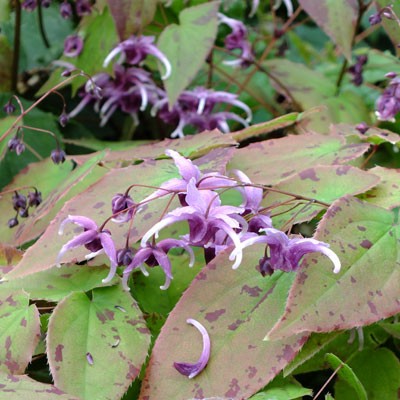
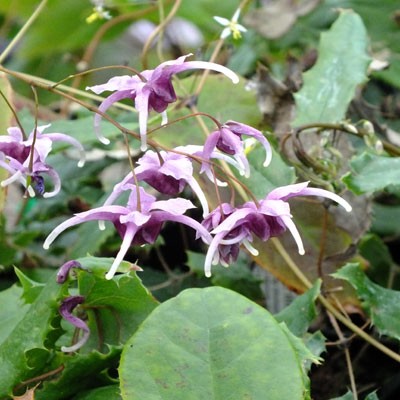
Potsize - 1L
Flowers appear richly coloured in heavy sprays. The sepals are small and lilac, under which curve much larger petal 'claws', deep purple in the centre fading to near white at the curved tips. New leaves are a fresh apple green, staining orangey red towards the margins and then splashed in rich burgundy. Altogether a most attractive cultivar. Raised by Wendy Perry of Bosvigo Garden, Truro from seed of Epimedium acuminatum, with a form of Epimedium grandiflorum as the other parent.Links
Epimedium Compared
Botanical Style Photographs
-


Potsize - 1L
Epimedium x warleyense ( Ellen Willmott ). E. alpinum x E. pinnatum subsp. colchicum. The upright stems of delicate coppery orange flowers set this hybrid apart from most epimediums. They are held well up above the foliage in a warm orange haze. The leaves are apple green in a mildly spreading clump that is a little less dense than most species. Height 20-40cm in flower. Originally sent from Warley Place, the Garden of Ellen Willmot, to Professor Stearn as E.perraldianum when he was writing his monograph. Subsequently identified and named by Professor Stearn. for any good soil in partial shade. spring.Discount of 25p per plant for quantities of 3 or overLinks
Epimedium Compared
Botanical Style Photographs
- Home
- Quick Link
Using the letter tabs on the left will bring up quick links to all the Genera we grow.
Please note that you can still access genera where there are no plants currently in stock, in which case a blank page will load.A-B
C-D
C
- Caltha
- Camassia
- Campanula
- Cardamine
- Cardiocrinum
- Centaurea
- Cephalaria
- Chaerophyllum
- Chamaenerion
- Chrysanthemum
- Cimicifuga
- Cirsium
- Clematis
- Codonopsis
- Convallaria
- Coreopsis
- Coronilla
- Corydalis
- Cosmos
- Crambe
- Crocosmia
- Cryptotaenia
- Cyclamen
- Cynara
- Cyrtanthus
D
- Darmera
- Delphinium
- Dendranthema
- Diascia
- Dicentra
- Dictamnus
- Dierama
- Digitalis
- Diplarrena
- Disporopsis
- Disporum
- Dodecatheon
- Close
E-H
E-F
- Echinacea
- Echinops
- Epilobium
- Epimedium
- Equisetum
- Erigeron
- Erigeron
- Eryngium
- Erysimum
- Eucomis
- Eupatorium
- Euphorbia
- Eurybia
- Ficaria
- Filipendula
- Foeniculum
- Fragaria
- Francoa
G=H
- Gaillardia
- Galium
- Gaura
- Gentiana
- Geranium
- Geum
- Gillenia
- Gladiolus
- Gunnera
- Gypsophila
- Hacquetia
- Helenium
- Helianthemum
- Helianthus
- Heliopsis
- Hellebous
- Hemerocallis
- Hesperantha
- Hesperis
- Heuchera
- Heucherella
- Hosta
- Close
I-N
O-R
O
- Oenothera
- Omphalodes
- Ononis
- Onopordum
- Ophiopogon
- Origanum
- Osteospermum
P
- Pachyphragma
- Paeonia
- Papaver
- Parahebe
- Peltiphyllum
- Penstemon
- Persicaria
- Phlomis
- Phlox
- Physalis
- Pimpinella
- Polemonium
- Polygonatum
- Polygonum
- Potentilla
- Primula
- Pulmonaria
- Pulsatilla
R
- Ranunculus
- Ratibida
- Rehmannia
- Reineckea
- Rheum
- Rodgersia
- Roscoea
- Rudbeckia
- Close
S-Z
S
- Salvia
- Sanguisorba
- Saponaria
- Saxifraga
- Schizostylis
- Sedum
- Selinum
- Semiaquilegia
- Sidalcea
- Silene
- Sisyrinchium
- Smilacina
- Smyrnium
- Solidago
- Solidaster
- Sphaeraclcea
- Stachys
- Stemmacantha
- Stokesia
- Succisa
- Succisella
- Symphyotrichum
- Symphytum
T-U
- Tanacetum
- Tellima
- Thalictrum
- Thermopsis
- Tiarella
- Trachystemon
- Tradescantia
- Tricyrtis
- Trifolium
- Trollius
- Uvularia
V-Z
- Valeriana
- Verbascum
- Verbena
- Vernonia
- Veronica
- Veronicastrum
- Vinca
- Viola
- Wulfenia
- Zantedeschia
- Zigadenus
- Close
Ferns & Grasses
- Close
- Online Store
- Dorset Perennials – Online Store
- Cart
- Checkout
- Testimonials
- Paper Order Form
Choose a Plant Group Here
- Close
- Comparisons

Pages with all the plants we grow in a Genus compared with photographs and descriptions
Choose these pages to browse through a whole collection of varieties quickly and easily without having to keep jumping through the shop pages.- Close

Botanical Style Photographs taken against a white background
Browse these pages to easily see how different varieties differ from one another. I've split them into 4 letter based tabs to make browsing easier. Or use the big button on the left to go to one page organised pictorially.- Close

Pages arranged along Taxonomic lines
Each page covers one Order (the level above Family) and lists all of the Families within that Order and then the contained Genera within that. They are designed to give you an overview of how different plants are related.- Classification of the Plant Kingdom ( some of it anyway !)
- Liliopsida (the monocots)
- Magnoliopsida (The dicots)
- Apiales ( Umbellifers )
- Asterales ( the Daisy Order )
- Boraginales ( the Borage Order )
- Brassicales ( the Cabbage Order )
- Caryophyllales ( the Carnation Order )
- Cornales ( the Dogwood Order )
- Dipsacales ( the Teasel Order )
- Ericales ( the Heather Order )
- Fabales ( the Bean Order )
- Gentianales ( the Gentian Order )
- Geraniales ( the Geranium Order )
- Lamiales ( the Deadnettle Order )
- Malpighiales
- Malvales ( the Mallow Order )
- Myrtales ( the Myrtle Order )
- Piperales
- Ranunculales
- Rosales ( the Rose Order )
- Sapindales
- Saxifragales ( the Saxifrage Order )
- Solanales ( the Potato Order )
- Close
- Polypodiopsida (Ferns)
- Close

- Close
- Advice and Colours

Here are pages showing plants growing alongside others
You'll find pictures of chance associations of plants on the nursery or pictures of plants growing in garden situations.- Achillea
- Lady’s Mantle (Alchemilla)
- Anthemis
- Astrantia
- Euphorbia
- Ferns
- Geraniums – cranesbills
- Hosta
- Nepeta – catmints
- Poppies
- Sedums
- Valeriana
- Close

Miscellaneous pages
Here are a collection of pages that didn't seem to fit anywhere else - pages on people or just collections of pretty pictures just for the sake of it.- A Wealth of Silver
- Bold Foliage Plants
- Delicate Patterns in the Frost
- High and Mighty
- Who is that Plant ? – The people behind the name
- Wildlife Pictures
- Woodlanders – plants for a cool position
- Close

A collection of pages offering advice
Here you'll find pages on where to site different ferns along with more general advice on perennials- Ferns for Moist Sites
- Ferns for Dry Shade
- Ferns – Deciduous or Evergreen ?
- What is a Perennial ?
- When to Plant Perennials
- Moth and Insect Repellent Plants
- Pot Size Guide
- Recent Posts
- Close


- Close
- FAQs and Policies
- My Account
It is necessary to create an account before the Wishlist function works correctly
- User Wishlist
- My Account
- Account Creation
- Logout
- Close
- Search
Whole Site Search ( will show pages and out of stock products)
Product Only Search ( will only show available products )
- Close
- Cart
- Checkout


























































